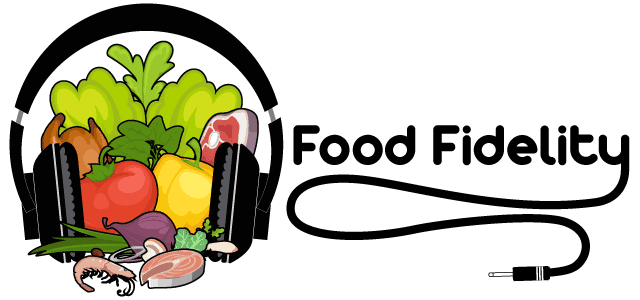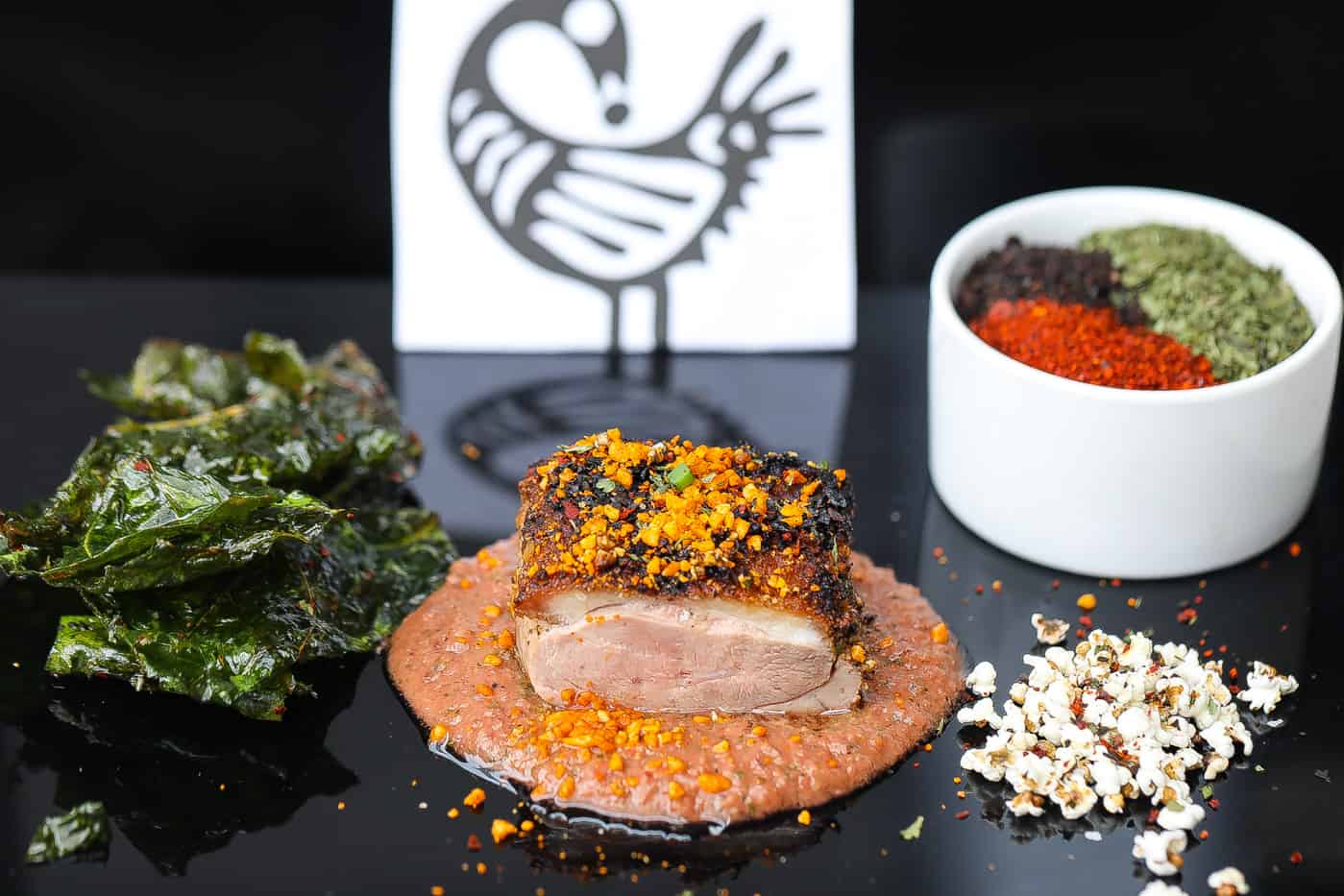This post may contain affiliate links via Amazon's affiliate advertising program. See privacy policy
Experience the tantalizing flavors of seared duck breast infused with West African suya spice—a fusion of savory and aromatic sensations in every bite!
Related Pan Seared Posts:
I’m proud to collaborate with more than 30 Black recipe developers as we celebrate Black History Month 2022. This Virtual Potluck explores Black food through the lens of Afrofuturism. Our collaboration of recipes explores the intersection of the Black diaspora via culture, future, geopolitics, imagination, liberation, culture, and technology.
My contribution is what I'm calling a "Sankofa Bowl," which is a Grilled Suya Duck Breast-based bowl concept. It features indigenous African ingredients and seasonings like Suya spice, sorghum, egusi seeds, and collard greens reimagined to reflect my vision of what black food could be and is.
Elevate your culinary experience with our tantalizing dish of seared duck breasts, expertly seasoned with fragrant suya spice and topped with a luscious cherry egusi sauce. This fusion of flavors brings together the rich and savory notes of the suya spice with the sweet and tangy essence of cherry egusi, creating a symphony of taste sensations that will delight your palate.
Each tender bite of succulent duck is perfectly complemented by the velvety texture and vibrant flavors of the cherry egusi sauce, making this a truly unforgettable dining experience. Prepare to embark on a culinary journey like no other, where every bite tells a story of tradition, innovation, and pure gastronomic bliss.

Black Food is often treated as this static, unevolved culinary tradition grounded only in iconic "soul food" dishes. Black food is indeed that, but it is also so much more. In more recent times through the contributions of black culinary scholars and historians origin stories of black food have gotten attention, but it is still early.
Attention to the future of black food has basically been non-existent. This is why this year's focus on Afro-futurism is so important as it explores the intersection of the past, current, and future in a way that showcases both the diversity of black food and the shared connections across the entire African diaspora.
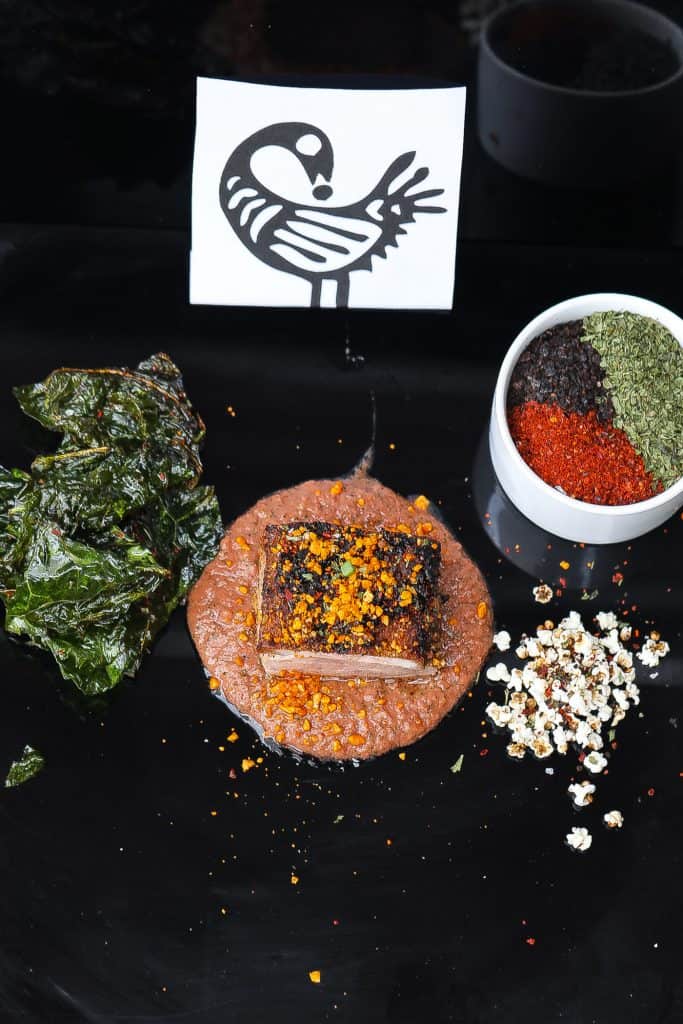
What is Sankofa?
Sankofa is an African word/concept from the Akan tribe in Ghana. The theme is "Sankofa" as represented by the iconic bird that moves forward while looking back symbolic of the act of revisiting the past, taking those learnings of value, and using them as a guide to improving the future. In this sense, there is much value placed on knowing one's history and learning from it.
From a culinary and foodways perspective there is high unawareness of food crops indigenous African food crops that have contributed to Western nations especially, the U.S. The same negative, racist views that Westerners hold towards black folk drive their views on African indigenous food crops and agricultural systems so the stories and history of these amazing crops don't get told and are not as revered as crops indigenous to Mexico, South America, etc.
This lack of awareness and appreciation is acutely relevant in several contexts.
- Black peoples' contributions continue to be devalued and we will not be able to resolve our racist past until we can start to see black people differently
- Indigenous crops like okra, sorghum grain, fonio, teff, cowpeas, yams, leafy greens, egusi melons, etc. survived and thrived harsh dry climates. Western societies have focused on the commercialization of these crops and their exploitation, but the reality is that their history and ancient methods of cultivation likely hold the key to solving for issues created by climate change.
- Africa on the whole hasn't benefitted proportionally from it's indigenous crops, as global economic pressures have led to outside crops displacing many local crops ones.
In the spirit of Sankofa, if we study the history of ancient African agricultural practices we may find answers to many of the sustainability issues that plague us. Looking back just may offer improvement and/or correction going forward.
What is Suya?
Suya is Nigerian street food. It's usually beef served on skewers with a peanut-based seasoning and grilled over direct heat. Suya refers primarily to the technique but can also describe the flavor/seasoning. In this way, it's similar to Jamaican jerk seasoning. Suya can be applied to other meats like lamb or this duck breast.
What are Egusi Seeds?
Egusi or Agushi refers to the seeds from West African melons/gourds. They are essential to soups in the region. They are the primary ingredient in traditional egusi soup and are frequently used as a thickener in stews and soups.
Watermelons in American society have often involved racist tropes such as the picaninny caricature.
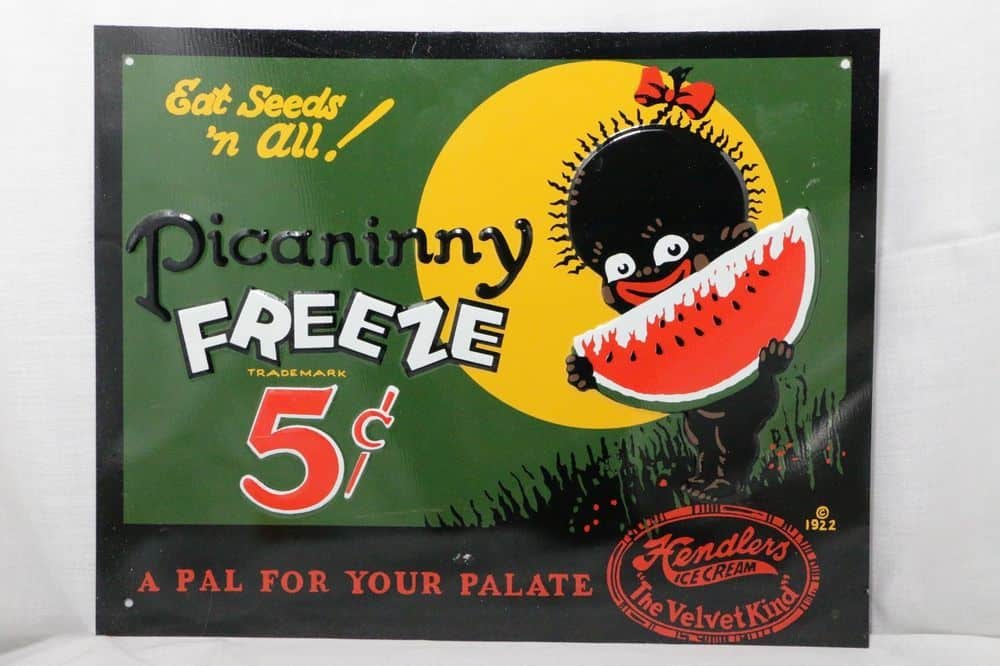
The reality is our ancient African ancestors cultivated this drought-resistant crop and have figured out ways to improve their profitability by intercropping them with crops like cassava, peppers, and tomatoes. This indigenous knowledge of melons can be critical to not only worldwide conservation strategies, but also solving for food insecurity issues.
Because they're so high in proteins they are seen as a great supplement to or substitute for meat-based dishes. I use them to add some protein to my morning smoothies.
Egusi is also essential to local economies in parts of West Africa. It's considered a cash crop particularly for women who earn relatively high earnings for harvesting and picking the seeds.
What is Sorghum?
If you grew up in the South you're likely familiar with sorghum as a sweetener like syrup or molasses. Sorghum is actually a gluten-free super whole grain similar to corn. Its origin like many things is in Africa where it was domesticated in the northeastern region (Ethiopia, Sudan, Egypt).
Tribal migrations throughout Africa and beyond meant it ended up in different parts of the world including India, China, and Australia. Eventually, slavery brought the crops from Africa to the U.S. where it is now one of the top crops in America. Sorghum grain is primarily used as livestock feed and for ethanol production, but it is growing as a consumer packaged goods.
Sorghum is quite versatile similar to most grains - as a side, in a salad, for risotto, or as popped similar to popcorn, but more like a miniature version. It has the potential to feed a starving world and counteract the progression of climate change. The U.S. is one of the top producers of Sorghum, but when you look at the amount of land dedicated to sorghum crop worldwide, outside of the African continent there isn't much.
Beats and Eats (music pairing for Suya Duck Breast)
In the spirit of reimagining and Sankofa I decided to pair J Dilla's "African Rhythms" with this Suya Duck Breast Bowl. J Dilla sampled Oneness of Juju's song of the same name and put his spin on it with more emphasis on the rhythm. The thing I've always appreciated most about Dilla's music is that though it's rooted in a very unique Detroit sound, he explores and pulls in black music from all over the world.
The original song is an anthem song about empowerment and liberation. Dilla takes it, keeps those elements, but also makes it groovy AF leaving you mesmerized and ready for whatever. In a similar way, this bowl has elements of many different regions of Africa. The Red, Black, and Green Liberation spice mix is the unifier while the peanut-based suya is the rhythm of the dish.
Grilled Suya Duck Breast Bowl Ingredients
For the Duck Breast
- Duck Breast
- Peanuts (unsalted)
- Kosher Salt
- Smoked Paprika
- Garlic Powder
- Ground Ginger
- Onion Powder
- Brown Sugar
- Cayenne Pepper
- Black Pepper
- Canolaor Olive Oil
For the Cherry-Egusi Sauce
- Fresh or Frozen Cherries
- Egusi Melon Seeds
- Shallots
- Scotch Bonnet Pepper (substitute Habanero if unavailable)
- Culantro (substitute Cilantro if unavailable)
- Fire Roasted Tomatoes
- Lime juice
- Salt
- Pepper
- Garlic Cloves
- Olive Oil
For the Fried Collard Greens
- Fresh Collard Greens
- Canola Oil for Frying
For the Popped Sorghum
- Sorghum
- Canola Oil
For the Liberation Spice Mix
- Aleppo Pepper
- Dried Cilantro
- Urfa Chili Flakes
- Kosher Salt
How to make Suya Duck Breast Bowls (step by step)
Make the Suya Duck
Place the peanuts into a food processor. Pulse until coarsely ground. Remove ground peanuts to a medium bowl and add all the spices. Mix well then add the oil to create a paste.
Score the skin side of the duck breast with a sharp knife. Either diamond shapes or straight lines work. You're only trying to cut the skin so avoid cutting too deep.
Place the breast in a large ziplock bag or bowl. Add the suya mixture and marinate in your fridge for at least an hour.
Fire up your grill and set it up for direct heat grilling. You'll want a hot fire (400-450 degrees). Clean and oil your grates using an oil-stained and folded paper towel.
Set a cast-iron skillet directly on your grill grates and allow to heat. Once your skillet is hot brush a little oil onto the surface. Add the duck breast skin side down and grill with the lid closed for 4-5 minutes.
Flip the duck breast and place it directly on the grates. Cook for 2-3 minutes more and check for doneness. Let duck breasts rest.
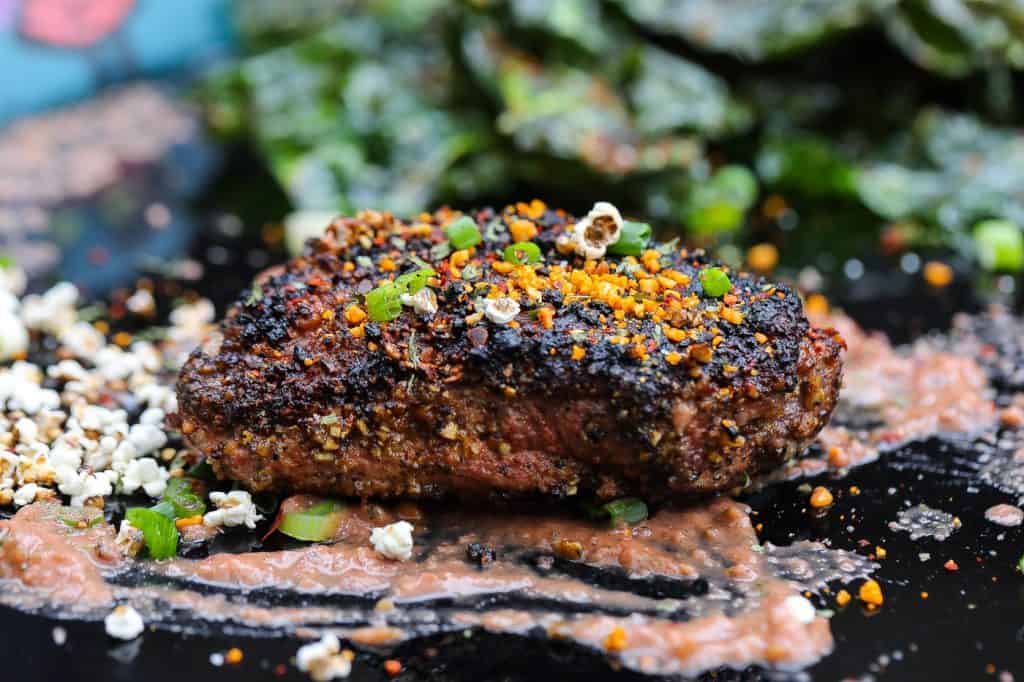
Make the Sauce
Add all the ingredients to a food processor. Pulse to desired consistency. I prefer the consistency of a smooth salsa. Set aside.
Make the Fried Collard Greens
Preheat a deep fryer to 325 degrees. Add chopped collard leaves to the fryer and cook for 2 minutes. Remove to a parchment paper-lined baking sheet and let rest.
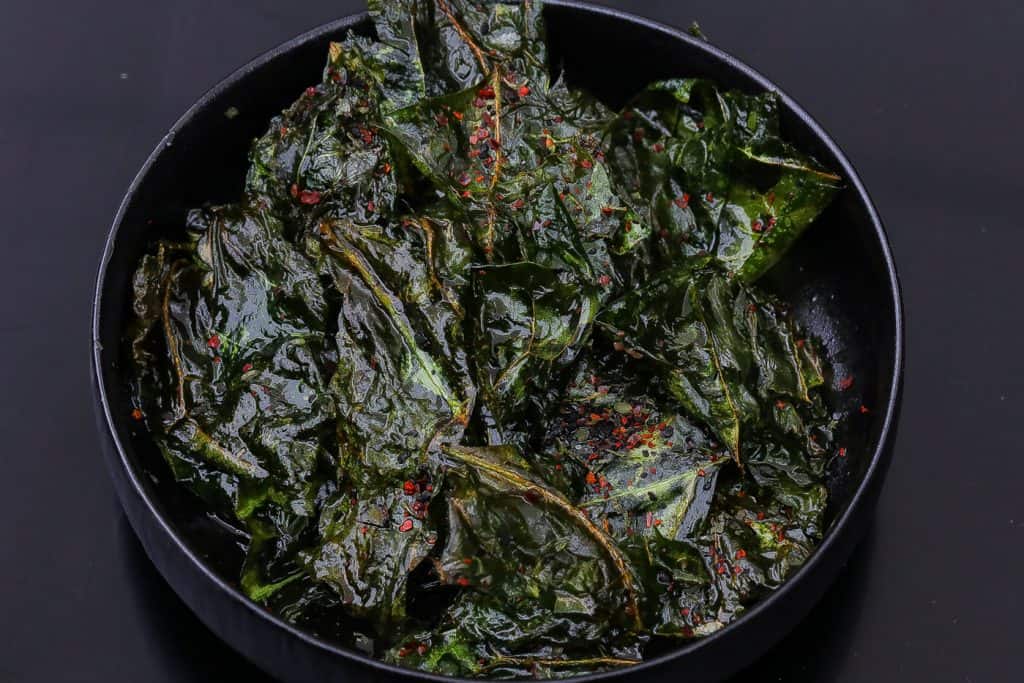
Make the Popped Sorghum
Pre-heat a large Dutch oven over medium heat. Add 1 teaspoon oil and coat the bottom of the pan thoroughly. Add half of the sorghum; cook about 1 minute or until sorghum popping slows, stirring constantly. Sorghum doesn't pop like corn. They're much smaller and unlikely to pop out of an uncovered pot assuming you're using a dutch oven.
Reduce heat to medium-low, and continue cooking 1 minute or until as much sorghum pops as possible, stirring constantly.
Remove the popped sorghum from the pan and repeat with the remaining sorghum. Set aside.
Assemble the Bowls
Ladle a large helping of the sauce in the bottom of a bowl. Top with the sorghum, then the sliced cooked duck breast. Add the collard green chips. Sprinkle some extra suya seasoning and chopped green onions on top. Enjoy!
What To Serve With Suya Duck Breasts
Pan-seared duck breasts pair well with a variety of delicious side dishes. Consider serving them with roasted potatoes or creamy mashed potatoes for a hearty accompaniment. Additionally, sautéed greens such as spinach or kale add a flavorful element to the meal.
For a touch of sweetness, roasted root vegetables like carrots or parsnips are a perfect choice. You can also serve the duck breasts with a fruity sauce, such as cherry or orange sauce, to complement their rich flavor. Finally, don't forget to include a crisp salad or some fresh herbs for a refreshing contrast.
Tips and Considerations For Suya Duck Breast Bowls
When cooking duck breast the cast-iron skillet is perfect for getting a really good sear, particularly on the skin side. This results in super crispy skin that you will love. By finishing the duck directly on the grates after the flip you get a tender and juicy duck internally.
If available to you add some cherry wood chips to your grilling to provide that deep and smoky cherry flavor that goes so well with duck. If using chips then soak them in water first.
You can cook the duck indoors as well right on the stovetop. A cast-iron skillet or indoor grill pan works great for this.
For the suya spice, I use unsalted peanuts since the dry spice mix calls for kosher salt. Using salted peanuts just adds more salt, to the point the dish becomes too salty.
Suya spice can be as hot or as mild as you make it. The key will be the ratio of cayenne pepper to brown sugar you go with. It's totally a personal preference thing. The ingredient ratio used in the recipe is fairly balanced so this isn't an overly hot version.
To keep things simple, I used canola oil throughout the recipe where oil is called for. So I fried the collard greens in canola, marinated the duck breast using canola, and even popped the sorghum in canola.
For the sauce I used frozen cherries and just thawed them out. This was strictly a cost-value thing as I buy the big Costco size frozen bag for my daily smoothies. If using fresh cherries, then make sure you remove the pits.
Egusi seeds aren't available in most mainstream grocery stores, but you'll likely find them in stores that serve African and possibly Caribbean ingredients. Otherwise, just order online.
I used the egusi seeds similar to how pumpkin or pepito seeds are used in moles.
I served all the ingredients in a deconstructed bowl, but feel free to serve them in a more traditional bowl structure - protein + grain + vegetables + sauce in a single bowl. For my traditional bowl I actually changed up the sorghum and cooked the grain in equal parts coconut milk and water vs. popped.
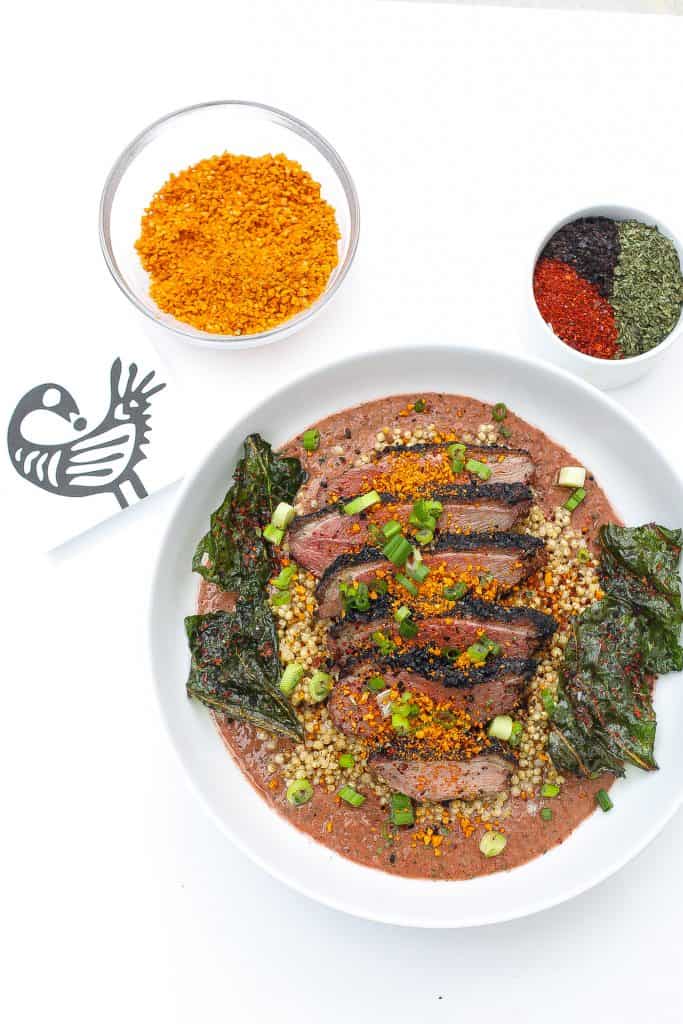
Frequently Asked Questions for Cooking Duck Breasts
What does duck breast taste like?
Though it's a bird, duck breast tastes nothing like chicken. Taste and texture-wise it's like red meat. Duck is rich and fatty so it has a stronger taste profile.
How long does duck breast take to cook?
It depends on how you plan to cook. This grilled recipe calls for an estimated 10 minutes of cook time max assuming you hit and maintain the right temperatures.
How well should duck breast be cooked?
I like my duck breast like I like my steaks, i.e. medium-rare. To cook to medium-rare your internal temperature should be in the 130-135 degrees F range. I like to remove mine off the heat just before reaching the temperature the meat will continue to cook some off heat. Use a meat thermometer to check.
Where Can You Find Duck Breast?
Duck breast is a typical farmer's market, butcher, or specialty grocer-type ingredient. You may luck up and find it in your neighborhood grocery but it's less likely.
Where to find egusi seeds?
Unless you live near an African market, it's easier to buy egusi seeds online. Amazon has lots of options.
For similar recipes try these:
Beef Suya Skewers
Duck Fat Smashed Sweet Potatoes
Purple Kale Chips
Southern Collard Greens
Blackened Chicken
make this pan seared duck breast recipe
Our dish of seared duck breasts seasoned with suya spice and topped with cherry egusi sauce is a true celebration of flavor and creativity. From the aromatic spices of the suya seasoning to the sweet and tangy notes of the cherry egusi sauce, each element of this dish has been carefully crafted to delight the senses.
Whether enjoyed as a special occasion meal or a gourmet dinner at home, these succulent duck breasts are sure to impress even the most discerning of palates. Prepare to savor every mouthful and indulge in the rich flavors of this culinary masterpiece.
If you make this seared duck breast recipe or any other from the site, please come back and leave me a comment below with your feedback. Definitely take a photo of the dish and be sure to tag #foodfidelity so that I can see them.
You can also keep up with my food exploits as well as original recipes! You can find me on Instagram, Facebook, Twitter, and Pinterest. If you like any of the music you find on the site, visit me at Spotify to find curated monthly playlists.
Lastly, go to my YouTube channel and subscribe to be notified when new weekly videos are uploaded.
Ingredients
For the Duck Breast
- 2 8 oz Duck Breasts
- 2 cups Peanuts unsalted
- 1 teaspoon Kosher Salt
- 1 teaspoon Smoked Paprika
- ½ teaspoon Garlic Powder
- ¼ teaspoon Ground Ginger
- ½ teaspoon Onion Powder
- 1 teaspoon Brown Sugar
- ¼ teaspoon Cayenne Pepper
- 1 teaspoon Black Pepper
- ¼ cup Canola Oil
For the Cherry-Egusi Sauce
- 1 cup Fresh or Frozen Cherries de-pitted
- 2 tablespoons Egusi Melon Seeds
- 2 medium Shallots peeled
- 1 whole Scotch Bonnet Pepper substitute Habanero if unavailable, deseeded and deveined
- ¼ cup Culantro substitute Cilantro if unavailable, roughly chopped
- 14 oz Fire Roasted Tomatoes
- 1 small Lime juiced
- ½ teaspoon Salt
- ½ teaspoon Pepper
- 3 cloves Garlic roughly chopped
- 2 tablespoons Olive Oil
For the Fried Collard Greens
- 1 bunch Fresh Collard Greens de-stemmed and roughly chopped
- Canola Oil for frying
For the Popped Sorghum
- ½ cup Sorghum
- 1 tablespoon Canola Oil
For the Liberation Spice Mix
- 1 teaspoon Aleppo Pepper
- ½ teaspoon Dried Cilantro
- ½ teaspoon Urfa Chili Flakes
- ½ teaspoon Kosher Salt
Instructions
Make the Suya Duck
- Place the peanuts into a food processor. Pulse until coarsely ground. Remove ground peanuts to a medium bowl and add all the spices. Mix well then add the oil to create a paste.
- Score the skin side of the duck breast with a sharp knife. Either diamond shapes or straight lines work. You're only trying to cut the skin so avoid cutting too deep.
- Place the breast in a large ziplock bag or bowl. Add the suya mixture and marinate in your fridge for at least an hour.
- Fire up your grill and set it up for direct heat grilling. You'll want a hot fire (400-450 degrees). Clean and oil your grates using an oil-stained and folded paper towel.
- Set a cast-iron skillet directly on your grill grates and allow to heat. Once your skillet is hot brush a little oil onto the surface. Add the duck breast skin side down and grill with the lid closed for 4-5 minutes.
- Flip the duck breast and place it directly on the grates. Cook for 2-3 minutes more and check for doneness.
Make the Sauce
- Add all the ingredients to a food processor. Pulse to desired consistency. I prefer the consistency of a smooth salsa. Set aside.
- Make the Fried Collard Greens
- Preheat a deep fryer to 325 degrees. Add chopped collard leaves to the fryer and cook for 2 minutes. Remove to a parchment paper-lined baking sheet, season with spice mix, and let rest.
Make the Popped Sorghum
- Pre-heat a large Dutch oven over medium heat. Add 1 teaspoon oil and coat the bottom of the pan thoroughly. Add half of the sorghum; cook about 1 minute or until sorghum popping slows, stirring constantly. Sorghum doesn't pop like corn. They're much smaller and unlikely to pop out of an uncovered pot assuming you're using a dutch oven.
- Reduce heat to medium-low, and continue cooking 1 minute or until as much sorghum pops as possible, stirring constantly.
- Remove the popped sorghum from the pan and repeat with the remaining sorghum. Season with the spice mix. Set aside.
Video

